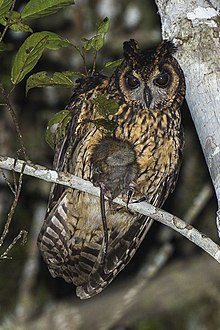Madagascar owl
| Madagascar owl | |
|---|---|

| |
| Scientific classification | |
| Kingdom: | |
| Phylum: | |
| Class: | |
| Order: | |
| Family: | |
| Genus: | |
| Species: | A. madagascariensis
|
| Binomial name | |
| Asio madagascariensis (A. Smith, 1834)
| |
The Madagascan owl (Asio madagascariensis), also known as the Madagascan long-eared owl,[1] is a medium sized owl endemic to the island of Madagascar.[2] It is sometimes considered to be conspecific with the long-eared owl (Asio otus.)[3] It ranges from 40–50 centimetres (16–20 in) in length, making it the largest of the country's owls; females are larger than males.[2]
Its upperparts, crown and nape are brownish-black while its underparts are buff with black streaking. It has a brown facial disk, black bill and orange eyes. Its long ear tufts are dark brown, flecked with tan, matching the head.[2]
Its call is usually a series of barks, varying in pitch and volume, but sometimes it will utter a series of more hoot-like notes, described by some as ulooh.
It is generally found at elevations ranging from sea level to 1,600 metres (5,200 ft),[2] though it occasionally ranges as high as 1,800 metres (5,900 ft).[4] It inhabits a variety of woodland habitats.
Like most owls, the Madagascan owl is nocturnal, roosting by day in dense foliage. It feeds mainly on small mammals, hunting either in the forest or in open areas nearby.[2]
Little is known about its breeding biology.[4] It is thought to lay its eggs in stick nests created by other animals.
Preys
They feed on:[5]
- Amphibians (Boophis )- 2%
- Reptiles (Uroplatus ) - 3.3%
- Birds (Eurystomos glaucurus - 8%, Hypsipetes madagascariensis - 2.7%), total: 10.7%
but mainly with
- Mammals (Hipposiderus commersoni - 2.8%; Eliurus myoxinus - 27.9%; Eliurus minor 5.7%; Rattus Rattus - 37.1%; Microcebus rufus - 10.7%), total: 84.2%
This species is not globally threatened, but its status is not certain.
References
- ^ a b Template:IUCN
- ^ a b c d e Morris, Pete; Hawkins, Frank (1998). Birds of Madagascar: A Photographic Guide. Mountfield, East Sussex, UK: Pica Press. p. 204. ISBN 1-873403-45-3.
- ^ Sibley, Charles Gald; Monroe, Burt Leavelle (1990). Distribution and Taxonomy of Birds of the World. Yale University Press. p. 182. ISBN 0-300-04969-2.
- ^ a b Duncan, James R. (2003). Owls of the World: Their Lives, Behavior and Survival. Richmond Hill, Ontario: Firefly Books. p. 287. ISBN 1-55297-845-1.
- ^ zfmk.de - The Food Habits of the Madagascar Long-eared Owl

